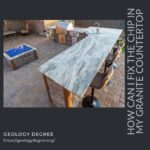Coquina is a sedimentary rock mainly made up of sand-size fossil fuels. The rock is composed of either wholly or almost entirely transported, abraded, or mechanically sorted fragments of the shells of invertebrates.
The word “coquina” comes from the Greek word “cockle.” A rock is labeled coquina if it has particles equal to or exceeding 2 millimeters. Coquina hardness varies from one specimen to another specimen based on its cementation. Poorly cemented particles are soft compared to moderately and fully cemented rocks.

Rock Composition
Coquina is made up mainly of calcite (a mineral). The calcite often includes phosphate in the form of seashells or coral. The calcite or calcium carbonate is in the form of aragonite when coquina deposits are young. Mollusks and gastropods use aragonite to build their shells. It is then transformed into calcite during diagenesis.
Coquina Types
Coquina is divided into three types based on grain size and matrix characteristics. These types are summarized below.
Coquinite: It is similar to coquina in many ways, but the shell debris in this rock is more firmly cemented. The grain size is usually larger than 2 millimeters with low porosity.
Microcoquina: The shell particles are much smaller in this type. The grain size is smaller than 2 millimeters and has high porosity.
Coquinoid Limestone: The spaces between the shell debris are occupied by fine-grained carbonate material. The rock has a grain size lower than 2 millimeters and low porosity.
Coquina Formation
Coquina formation requires a steady and abundant supply of fossil debris, the same size as sand particles. It is usually formed in shallow coastal waters where steady and strong waves and currents deliver fossil debris. These waves must be strong enough to remove all the clay and tiny particles. However, they must not be so strong that they erode fossil debris accumulation.
Coquina is mostly formed in tropical and subtropical marine waters because fossil debris is abundant here. Common sites for coquina formation are ocean beaches, barrier islands, shallow offshore bars, or tidal channels. The rock unit may develop sedimentary structures like bedding, cross-bedding, and ripple marks.
Coquina reserves can also form in freshwater environments like lakeshores and river channels. Once the rocks are deposited, calcium carbonate is usually precipitated within the sediment in the form of the sediment that binds fossil debris together. Cementation is compulsory to transform sediment into sedimentary rock.
Where is Coquina Found?
Coquina is not a common rock. The most notable reserves are located along Florida and the North Caroline coastline. Coquina deposits are also found in Australia, Brazil, the United Kingdom, and Mexico.
The most notable coquina exposures around the world include.
- Blowing Rocks Preserve, Palm Beach County, Florida
- Kure Beach, New Hanover County, North Carolina
- Much Wenlock Limestone Formation, Shropshire, England
- Odesa Catacombs, Ukraine
- Shell Beach, Shark Bay, Western Australia
- Washington Oaks State Gardens, Flagler County, Florida

Coquina Uses
Coquina has been used to make castles and towers in areas where it is available. You would notice structures made from coquina near its reserves. Bok Tower, Castillo de San Marcos, and Fort Matanzas National Monument in Florida are some of the most notable ones.
Some petroleum-bearing formations also hold coquina reservoirs of oil. An example is the recently discovered formations in Brazil.
Coquina has been used as a building stone in Florida for over 400 years. The coquina was used for constructing buildings in Western Australia, but its mining is prohibited because these machines are now a part of the World Heritage Site.
Crushed coquina is also used as a fertilizer because it often includes phosphates.
The rock is soft after mining; it cannot be used as a construction material. It is then allowed to dry for 1-3 years after quarrying to be used in construction. However, its use is limited due to a long drying time. However, coquina has shown an extreme deviation from this property in the 18th century. It was used to build Castillo de San Marcos, a Spanish Fort, on the western shore of Matanzas Bay at St. Augustine, Florida. The fort was attacked by English ships in 1702. The coquina walls of the castle resisted the cannon balls. The cannon balls embedded themselves in the thick coquina blocks. The walls restricted another attack in 1740. Hence, this rock is often known as Coquina – The Rock that Saved St Augustine.








